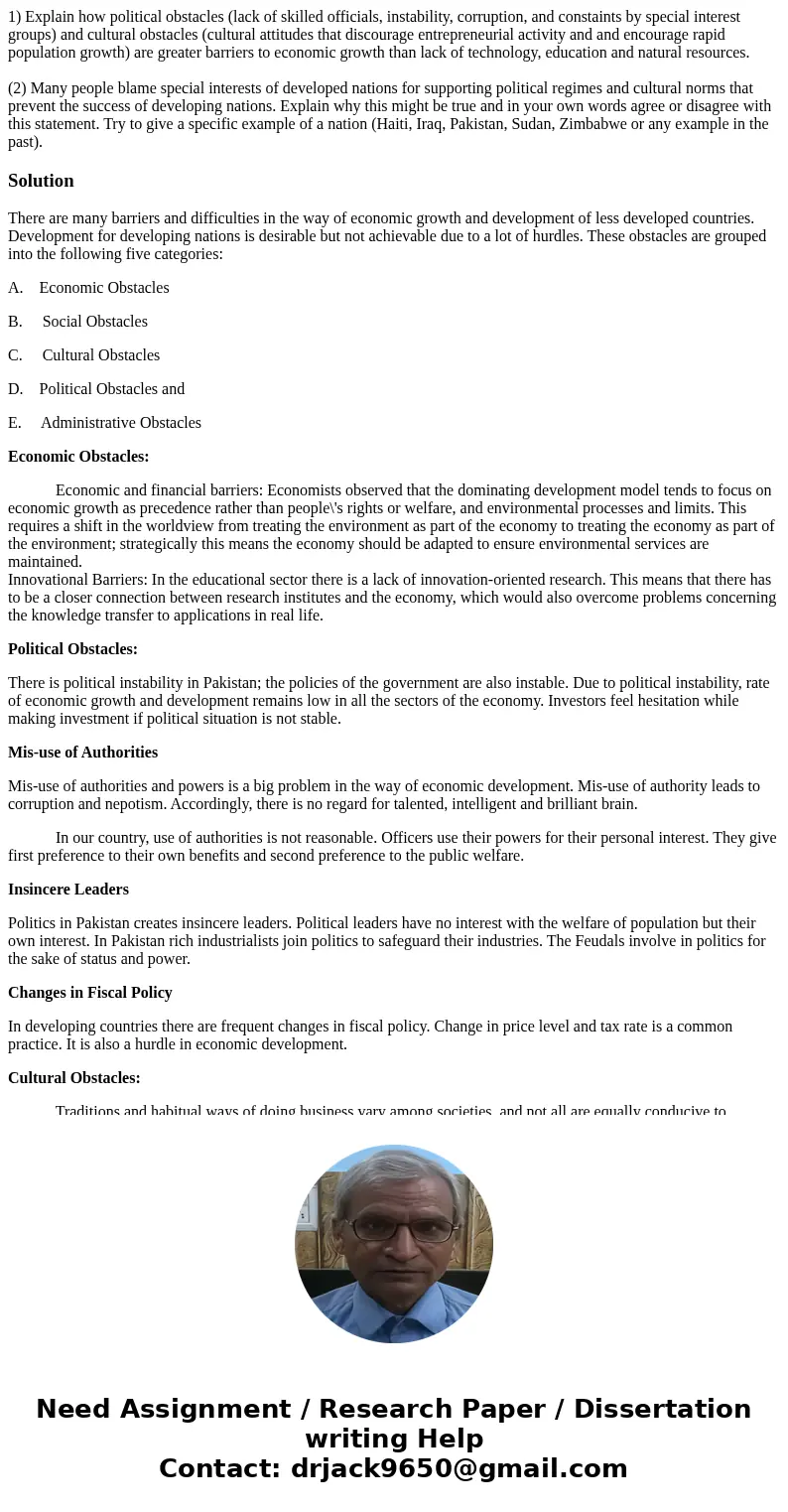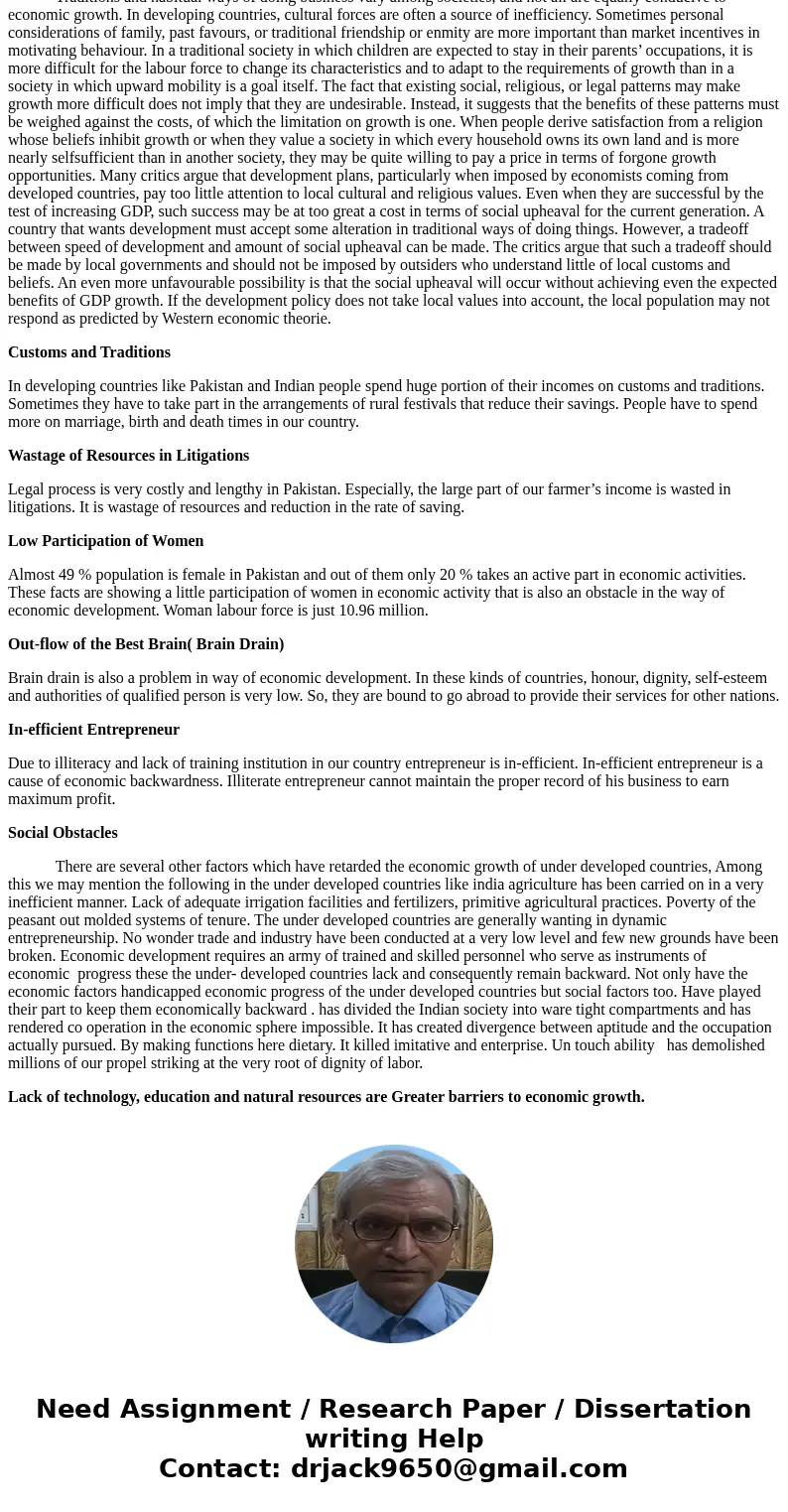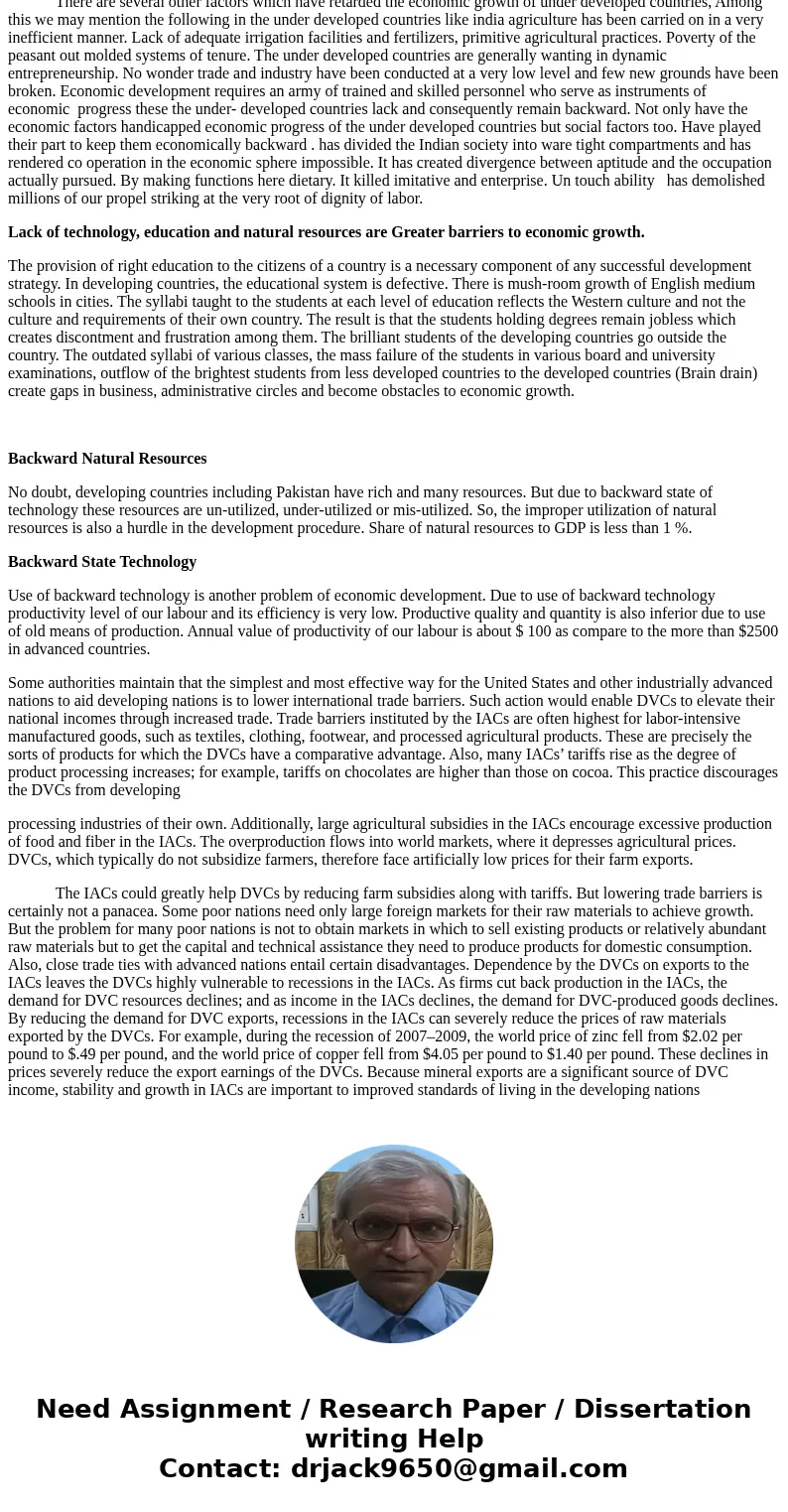1 Explain how political obstacles lack of skilled officials
1) Explain how political obstacles (lack of skilled officials, instability, corruption, and constaints by special interest groups) and cultural obstacles (cultural attitudes that discourage entrepreneurial activity and and encourage rapid population growth) are greater barriers to economic growth than lack of technology, education and natural resources.
(2) Many people blame special interests of developed nations for supporting political regimes and cultural norms that prevent the success of developing nations. Explain why this might be true and in your own words agree or disagree with this statement. Try to give a specific example of a nation (Haiti, Iraq, Pakistan, Sudan, Zimbabwe or any example in the past).
Solution
There are many barriers and difficulties in the way of economic growth and development of less developed countries. Development for developing nations is desirable but not achievable due to a lot of hurdles. These obstacles are grouped into the following five categories:
A. Economic Obstacles
B. Social Obstacles
C. Cultural Obstacles
D. Political Obstacles and
E. Administrative Obstacles
Economic Obstacles:
Economic and financial barriers: Economists observed that the dominating development model tends to focus on economic growth as precedence rather than people\'s rights or welfare, and environmental processes and limits. This requires a shift in the worldview from treating the environment as part of the economy to treating the economy as part of the environment; strategically this means the economy should be adapted to ensure environmental services are maintained.
Innovational Barriers: In the educational sector there is a lack of innovation-oriented research. This means that there has to be a closer connection between research institutes and the economy, which would also overcome problems concerning the knowledge transfer to applications in real life.
Political Obstacles:
There is political instability in Pakistan; the policies of the government are also instable. Due to political instability, rate of economic growth and development remains low in all the sectors of the economy. Investors feel hesitation while making investment if political situation is not stable.
Mis-use of Authorities
Mis-use of authorities and powers is a big problem in the way of economic development. Mis-use of authority leads to corruption and nepotism. Accordingly, there is no regard for talented, intelligent and brilliant brain.
In our country, use of authorities is not reasonable. Officers use their powers for their personal interest. They give first preference to their own benefits and second preference to the public welfare.
Insincere Leaders
Politics in Pakistan creates insincere leaders. Political leaders have no interest with the welfare of population but their own interest. In Pakistan rich industrialists join politics to safeguard their industries. The Feudals involve in politics for the sake of status and power.
Changes in Fiscal Policy
In developing countries there are frequent changes in fiscal policy. Change in price level and tax rate is a common practice. It is also a hurdle in economic development.
Cultural Obstacles:
Traditions and habitual ways of doing business vary among societies, and not all are equally conducive to economic growth. In developing countries, cultural forces are often a source of inefficiency. Sometimes personal considerations of family, past favours, or traditional friendship or enmity are more important than market incentives in motivating behaviour. In a traditional society in which children are expected to stay in their parents’ occupations, it is more difficult for the labour force to change its characteristics and to adapt to the requirements of growth than in a society in which upward mobility is a goal itself. The fact that existing social, religious, or legal patterns may make growth more difficult does not imply that they are undesirable. Instead, it suggests that the benefits of these patterns must be weighed against the costs, of which the limitation on growth is one. When people derive satisfaction from a religion whose beliefs inhibit growth or when they value a society in which every household owns its own land and is more nearly selfsufficient than in another society, they may be quite willing to pay a price in terms of forgone growth opportunities. Many critics argue that development plans, particularly when imposed by economists coming from developed countries, pay too little attention to local cultural and religious values. Even when they are successful by the test of increasing GDP, such success may be at too great a cost in terms of social upheaval for the current generation. A country that wants development must accept some alteration in traditional ways of doing things. However, a tradeoff between speed of development and amount of social upheaval can be made. The critics argue that such a tradeoff should be made by local governments and should not be imposed by outsiders who understand little of local customs and beliefs. An even more unfavourable possibility is that the social upheaval will occur without achieving even the expected benefits of GDP growth. If the development policy does not take local values into account, the local population may not respond as predicted by Western economic theorie.
Customs and Traditions
In developing countries like Pakistan and Indian people spend huge portion of their incomes on customs and traditions. Sometimes they have to take part in the arrangements of rural festivals that reduce their savings. People have to spend more on marriage, birth and death times in our country.
Wastage of Resources in Litigations
Legal process is very costly and lengthy in Pakistan. Especially, the large part of our farmer’s income is wasted in litigations. It is wastage of resources and reduction in the rate of saving.
Low Participation of Women
Almost 49 % population is female in Pakistan and out of them only 20 % takes an active part in economic activities. These facts are showing a little participation of women in economic activity that is also an obstacle in the way of economic development. Woman labour force is just 10.96 million.
Out-flow of the Best Brain( Brain Drain)
Brain drain is also a problem in way of economic development. In these kinds of countries, honour, dignity, self-esteem and authorities of qualified person is very low. So, they are bound to go abroad to provide their services for other nations.
In-efficient Entrepreneur
Due to illiteracy and lack of training institution in our country entrepreneur is in-efficient. In-efficient entrepreneur is a cause of economic backwardness. Illiterate entrepreneur cannot maintain the proper record of his business to earn maximum profit.
Social Obstacles
There are several other factors which have retarded the economic growth of under developed countries, Among this we may mention the following in the under developed countries like india agriculture has been carried on in a very inefficient manner. Lack of adequate irrigation facilities and fertilizers, primitive agricultural practices. Poverty of the peasant out molded systems of tenure. The under developed countries are generally wanting in dynamic entrepreneurship. No wonder trade and industry have been conducted at a very low level and few new grounds have been broken. Economic development requires an army of trained and skilled personnel who serve as instruments of economic progress these the under- developed countries lack and consequently remain backward. Not only have the economic factors handicapped economic progress of the under developed countries but social factors too. Have played their part to keep them economically backward . has divided the Indian society into ware tight compartments and has rendered co operation in the economic sphere impossible. It has created divergence between aptitude and the occupation actually pursued. By making functions here dietary. It killed imitative and enterprise. Un touch ability has demolished millions of our propel striking at the very root of dignity of labor.
Lack of technology, education and natural resources are Greater barriers to economic growth.
The provision of right education to the citizens of a country is a necessary component of any successful development strategy. In developing countries, the educational system is defective. There is mush-room growth of English medium schools in cities. The syllabi taught to the students at each level of education reflects the Western culture and not the culture and requirements of their own country. The result is that the students holding degrees remain jobless which creates discontment and frustration among them. The brilliant students of the developing countries go outside the country. The outdated syllabi of various classes, the mass failure of the students in various board and university examinations, outflow of the brightest students from less developed countries to the developed countries (Brain drain) create gaps in business, administrative circles and become obstacles to economic growth.
Backward Natural Resources
No doubt, developing countries including Pakistan have rich and many resources. But due to backward state of technology these resources are un-utilized, under-utilized or mis-utilized. So, the improper utilization of natural resources is also a hurdle in the development procedure. Share of natural resources to GDP is less than 1 %.
Backward State Technology
Use of backward technology is another problem of economic development. Due to use of backward technology productivity level of our labour and its efficiency is very low. Productive quality and quantity is also inferior due to use of old means of production. Annual value of productivity of our labour is about $ 100 as compare to the more than $2500 in advanced countries.
Some authorities maintain that the simplest and most effective way for the United States and other industrially advanced nations to aid developing nations is to lower international trade barriers. Such action would enable DVCs to elevate their national incomes through increased trade. Trade barriers instituted by the IACs are often highest for labor-intensive manufactured goods, such as textiles, clothing, footwear, and processed agricultural products. These are precisely the sorts of products for which the DVCs have a comparative advantage. Also, many IACs’ tariffs rise as the degree of product processing increases; for example, tariffs on chocolates are higher than those on cocoa. This practice discourages the DVCs from developing
processing industries of their own. Additionally, large agricultural subsidies in the IACs encourage excessive production of food and fiber in the IACs. The overproduction flows into world markets, where it depresses agricultural prices. DVCs, which typically do not subsidize farmers, therefore face artificially low prices for their farm exports.
The IACs could greatly help DVCs by reducing farm subsidies along with tariffs. But lowering trade barriers is certainly not a panacea. Some poor nations need only large foreign markets for their raw materials to achieve growth. But the problem for many poor nations is not to obtain markets in which to sell existing products or relatively abundant raw materials but to get the capital and technical assistance they need to produce products for domestic consumption. Also, close trade ties with advanced nations entail certain disadvantages. Dependence by the DVCs on exports to the IACs leaves the DVCs highly vulnerable to recessions in the IACs. As firms cut back production in the IACs, the demand for DVC resources declines; and as income in the IACs declines, the demand for DVC-produced goods declines. By reducing the demand for DVC exports, recessions in the IACs can severely reduce the prices of raw materials exported by the DVCs. For example, during the recession of 2007–2009, the world price of zinc fell from $2.02 per pound to $.49 per pound, and the world price of copper fell from $4.05 per pound to $1.40 per pound. These declines in prices severely reduce the export earnings of the DVCs. Because mineral exports are a significant source of DVC income, stability and growth in IACs are important to improved standards of living in the developing nations



 Homework Sourse
Homework Sourse